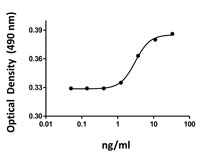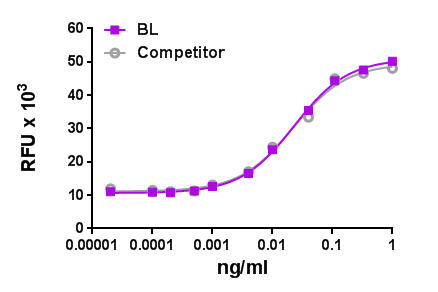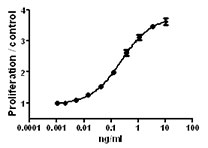- Regulatory Status
- RUO
- Other Names
- Fms-related tyrosine kinase 3 ligand, SL cytokine, Flt3 Ligand
- Ave. Rating
- Submit a Review
- Product Citations
- 4 publications
| Cat # | Size | Price | Quantity Check Availability | Save | ||
|---|---|---|---|---|---|---|
| 710802 | 10 µg | 203€ | ||||
This product is not available for shipping outside of the United States.
Fms-like tyrosine kinase 3 ligand is a hematopoietic cytokine structurally similar to stem cell factor (SCF) and colony stimulating factor 1 (CSF-1). Flt-3 ligand synergizes with other growth factors, such as interleukin-7 (IL-7) and CSFs, to promote proliferation and differentiation of early hematopoietic cells. In addition, Flt-3 ligand is involved in the commitment and expansion of dendritic cells as well as stimulating B cells, T cells, and NK cells. Both soluble form and membrane-bound forms of Flt-3 ligand are able to stimulate the cells expressing receptor tyrosine kinases Flt-3, transducing signals through the ERK and PI3K pathway. Flt-3 ligand is the only known ligand for Flt-3. Flt-3 and Flt-3 ligand have been implicated to participate in leukemogenesis, since the constitutively activated mutants of Flt-3 were found to be associated with the acute myeloid leukemia (AML).
Product DetailsProduct Details
- Source
- Human Flt-3 Ligand, amino acids (Thr27 - Ala181) (Accession# NP_004110.2) was expressed in E. coli.
- Molecular Mass
- The 155 amino acid recombinant protein has a predicted molecular mass of approximately 17.6 kD. The predicted N-terminal amino acid is Thr.
- Purity
- >98%, as determined by Coomassie stained SDS-PAGE.
- Formulation
- Lyophilized, carrier-free.
- Endotoxin Level
- Less than 0.1 ng per µg of protein.
- Concentration
- This product is bottled at the concentration indicated on the vial.
- Storage & Handling
- Unopened vial can be stored at -20°C or -70°C. For maximum results, quick spin vial prior to opening. Reconstitute in water to a concentration of 0.1-1.0 mg/ml. Do not vortex. It is recommended to further dilute in a buffer, such as 5% Trehalose, and store working aliquots at -20°C to -80°C. Avoid repeated freeze/thaw cycles.
- Activity
- ED50 ≤1.0 ng/ml, corresponding to a specific activity of ≥ 1.0 x 106 units/mg, as measured by its ability to stimulate the proliferation of human AML5 cells in a dose dependent manner.
- Application
-
Bioassay
- Product Citations
-
Antigen Details
- Structure
- Growth factor
- Distribution
-
Flt-3 ligand is expressed by hematopoietic cells and bone marrow stromal cells in both secreted and membrane bound form.
- Function
- Flt-3 ligand is a growth factor, stimulating differentiation, proliferation, and survival of hematopoietic progenitor cells.
- Interaction
- FLT-3 ligand targets myeloid progenitor cells, lymphoid progenitor cells, B cells, T cells, NK cells, and dendritic cells.
- Ligand/Receptor
- Flt-3
- Bioactivity
- Human Flt-3L is able to induce proliferation of AML5 cells.
- Biology Area
- Cell Biology, Stem Cells
- Molecular Family
- Cytokines/Chemokines, Growth Factors
- Antigen References
-
1. Ding Y, et al. 2014. J. Immunol. 192:1982.
2. Kreiter S, et al. 2011. Cancer Res. 71:6132.
3. Zheng R, et al. 2011. Oncogene 30:4004.
4. Rahman S, et al. 2011. J. Immunol. 186:390.
5. Sathaliyawala T, et al. 2010. Immunity 33:597.
6. Drexler HG and Quentmeier H, et al. 2004. Growth Factors 22:71. - Gene ID
- 2322 View all products for this Gene ID
- UniProt
- View information about FLT3L on UniProt.org
Related FAQs
- Why choose BioLegend recombinant proteins?
-
• Each lot of product is quality-tested for bioactivity as indicated on the data sheet.
• Greater than 95% Purity or higher, tested on every lot of product.
• 100% Satisfaction Guarantee for quality performance, stability, and consistency.
• Ready-to-use liquid format saves time and reduces challenges associated with reconstitution.
• Bulk and customization available. Contact us.
• Learn more about our Recombinant Proteins. - How does the activity of your recombinant proteins compare to competitors?
-
We quality control each and every lot of recombinant protein. Not only do we check its bioactivity, but we also compare it against other commercially available recombinant proteins. We make sure each recombinant protein’s activity is at least as good as or better than the competition’s. In order to provide you with the best possible product, we ensure that our testing process is rigorous and thorough. If you’re curious and eager to make the switch to BioLegend recombinants, contact your sales representative today!
- What is the specific activity or ED50 of my recombinant protein?
-
The specific activity range of the protein is indicated on the product datasheets. Because the exact activity values on a per unit basis can largely fluctuate depending on a number of factors, including the nature of the assay, cell density, age of cells/passage number, culture media used, and end user technique, the specific activity is best defined as a range and we guarantee the specific activity of all our lots will be within the range indicated on the datasheet. Please note this only applies to recombinants labeled for use in bioassays. ELISA standard recombinant proteins are not recommended for bioassay usage as they are not tested for these applications.
- Have your recombinants been tested for stability?
-
Our testing shows that the recombinant proteins are able to withstand room temperature for a week without losing activity. In addition the recombinant proteins were also found to withstand four cycles of freeze and thaw without losing activity.
- Does specific activity of a recombinant protein vary between lots?
-
Specific activity will vary for each lot and for the type of experiment that is done to validate it, but all passed lots will have activity within the established ED50 range for the product and we guarantee that our products will have lot-to-lot consistency. Please conduct an experiment-specific validation to find the optimal ED50 for your system.
- How do you convert activity as an ED50 in ng/ml to a specific activity in Units/mg?
-
Use formula Specific activity (Units/mg) = 10^6/ ED50 (ng/mL)

 Login / Register
Login / Register 














Follow Us